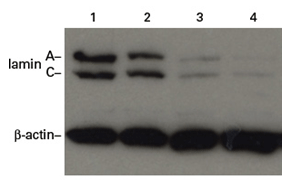»ó¼¼Á¤º¸
Tet-Inducible shRNA Systems
The Inducible RNAi Mechanism
Our inducible RNAi systems use a modified form of the tightly regulated, tetracycline-controlled gene expression system described by Gossen & Bujard (1). The system is designed so that expression of an shRNA is induced when doxycycline (Dox) is added to the culture medium (Figure 1). Induction of the shRNA results in suppression of its cognate target gene through innate cellular RNAi mechanisms. The system relies on two components: the tTS regulatory protein, which is a tetracycline-controlled transcriptional silencer (2, 3); and a Tet-responsive promoter (PTet/U6) that regulates the expression of your shRNA in response to the presence or absence of bound tTS.
The Inducible RNAi Mechanism
Our inducible RNAi systems use a modified form of the tightly regulated, tetracycline-controlled gene expression system described by Gossen & Bujard (1). The system is designed so that expression of an shRNA is induced when doxycycline (Dox) is added to the culture medium (Figure 1). Induction of the shRNA results in suppression of its cognate target gene through innate cellular RNAi mechanisms. The system relies on two components: the tTS regulatory protein, which is a tetracycline-controlled transcriptional silencer (2, 3); and a Tet-responsive promoter (PTet/U6) that regulates the expression of your shRNA in response to the presence or absence of bound tTS.
Plasmid and Retroviral Systems
With the Knockout Single Vector Inducible RNAi System, once your shRNA sequence is cloned in the pSingle-tTS-shRNA vector, the resulting plasmid contains all the features necessary for inducible gene knockdown (Figure 2).
The Knockout Tet RNAi Systems H and P. These hygromycin (H)- and puromycin (P)-selectable systems feature inducible retroviral shRNA expression vectors. A Tet-responsive cell line is created by transducing, selecting, and screening stable cell clones that express the tTS transcriptional silencer. Next, your tTS cell clone, or a premade tTS Cell Line, is transduced by your shRNA expression retrovirus, then clones are selected and screened for inducible shRNA expression in response to Dox.

Figure 1. The Knockout Inducible RNAi System is tightly regulated by the tTS transcriptional silencer. In the absence of Dox (Panel A), tTS binds tetO sequences in PTight/U6, while the KRAB domain of tTS renders the chromatin unable to support transcription of shRNA from the adjacent U6 promoter. Dox activates the Knockout System (Panel B) by binding to, and causing the dissociation of tTS from PTight/U6. This results in high-level shRNA transcription and rapid target gene knockdown.

Figure 2. Doxycycline-induced knockdown of lamin A/C in HeLa cells. A stable HeLa cell line that expresses an anti-lamin A/C shRNA was produced using the Knockout Single Vector System. Suppression of lamin A/C expression is evident after 6 hr of treatment with Dox, and knockdown was virtually complete after 48 hr. Lane 1: control. Lanes 2-4: 6 hr, 48 hr, and 72 hr, respectively.
References
1.Gossen, M. & Bujard, H. (1992) Proc. Natl. Acad. Sci. USA 89(12):5547-5551.
2.pTet-tTS Vector (April 1999) Clontechniques XIV(2):10-11.
3.Freundlieb, S. et al. (1999) J. Gene Med. 1(1):4-2.

